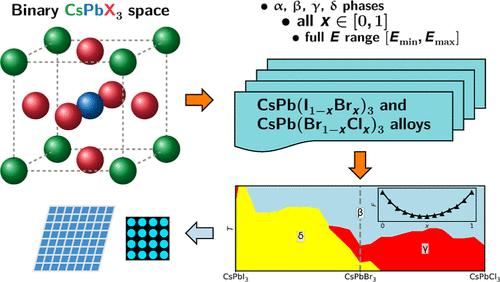当前位置:
X-MOL 学术
›
Chem. Mater.
›
论文详情
Our official English website, www.x-mol.net, welcomes your feedback! (Note: you will need to create a separate account there.)
Mixed-Halide Perovskite Alloys CsPb(I1–xBrx)3 and CsPb(Br1–xClx)3: New Insight of Configurational Entropy Effect from First-Principles and Phase Diagrams
Chemistry of Materials ( IF 8.6 ) Pub Date : 2024-04-11 , DOI: 10.1021/acs.chemmater.4c00571 Fang Pan 1 , Junni Zhai 1 , Jinyu Chen 1 , Lin Yang 1 , Hua Dong 2 , Fang Yuan 2 , Zhuangde Jiang 3 , Wei Ren 1 , Zuo-Guang Ye 4 , Guo-Xu Zhang 5 , Jingrui Li 1
Chemistry of Materials ( IF 8.6 ) Pub Date : 2024-04-11 , DOI: 10.1021/acs.chemmater.4c00571 Fang Pan 1 , Junni Zhai 1 , Jinyu Chen 1 , Lin Yang 1 , Hua Dong 2 , Fang Yuan 2 , Zhuangde Jiang 3 , Wei Ren 1 , Zuo-Guang Ye 4 , Guo-Xu Zhang 5 , Jingrui Li 1
Affiliation

|
Stability is one of the key issues in mixed-halide perovskite alloys that are promising in emergent optoelectronics. Previous density functional theory (DFT) and machine learning studies indicate that the formation-energy convex hulls of these materials are very shallow, and stable alloy compositions are rare. In this work, we revisit this problem using DFT, with a special focus on the effects of configurational and vibrational entropies. Allowed by the 20-atomic models for the and series, the partition functions and therewith thermodynamic state functions are calculated by traversing all possible mixed-halide configurations. We can thus evaluate the temperature- and system-dependent configurational entropy, which largely corrects the conventional approach based on the ideal solution model. Finally, temperature–composition phase diagrams that include α, β, γ, and δ phases of both alloys are constructed based on the free energy data, for which the contribution of phonon vibrations is included.
中文翻译:

混合卤化物钙钛矿合金 CsPb(I1–xBrx)3 和 CsPb(Br1–xClx)3:从第一原理和相图对构型熵效应的新见解
稳定性是混合卤化物钙钛矿合金的关键问题之一,该合金在新兴光电子学领域很有前景。先前的密度泛函理论(DFT)和机器学习研究表明,这些材料的地层能凸壳非常浅,稳定的合金成分很少见。在这项工作中,我们使用 DFT 重新审视这个问题,特别关注构型熵和振动熵的影响。 20 原子模型允许和系列中,配分函数及其热力学状态函数是通过遍历所有可能的混合卤化物配置来计算的。因此,我们可以评估与温度和系统相关的构型熵,这在很大程度上纠正了基于理想解模型的传统方法。最后,根据自由能数据构建了包括两种合金的 α、β、γ 和 δ 相的温度-成分相图,其中包括声子振动的贡献。
更新日期:2024-04-11
中文翻译:

混合卤化物钙钛矿合金 CsPb(I1–xBrx)3 和 CsPb(Br1–xClx)3:从第一原理和相图对构型熵效应的新见解
稳定性是混合卤化物钙钛矿合金的关键问题之一,该合金在新兴光电子学领域很有前景。先前的密度泛函理论(DFT)和机器学习研究表明,这些材料的地层能凸壳非常浅,稳定的合金成分很少见。在这项工作中,我们使用 DFT 重新审视这个问题,特别关注构型熵和振动熵的影响。 20 原子模型允许和系列中,配分函数及其热力学状态函数是通过遍历所有可能的混合卤化物配置来计算的。因此,我们可以评估与温度和系统相关的构型熵,这在很大程度上纠正了基于理想解模型的传统方法。最后,根据自由能数据构建了包括两种合金的 α、β、γ 和 δ 相的温度-成分相图,其中包括声子振动的贡献。



























 京公网安备 11010802027423号
京公网安备 11010802027423号